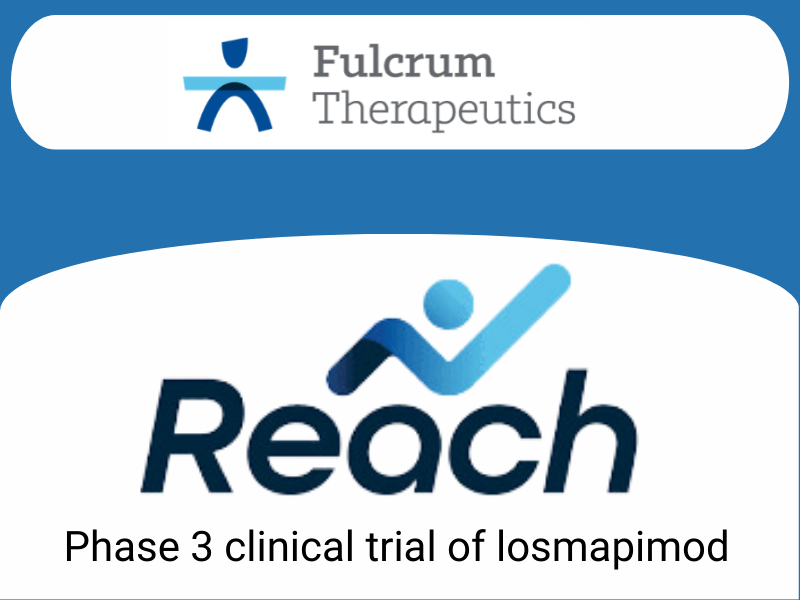REACH - Fulcrum Therapeutics
TRIAL NAME: Efficacy and Safety of Losmapimod in Treating Patients with Facioscapulohumeral Muscular Dystrophy (FSHD)
ABBREVIATION: REACH
STATUS: Enrollment completed Sept. 2023
THE BASICS
Who is conducting the clinical trial?
Fulcrum Therapeutics is conducting the study.
What is the purpose of the clinical trial?
REACH is a Phase 3 study of a medicine called losmapimod. The purpose of the study is to:
- Test whether losmapimod can slow or stop the progression of FSHD
- Evaluate how safe losmapimod is and what the side effects of taking it might be.
How does the medicine work?
FSHD is caused by expression of the DUX4 gene in muscles. Losmapimod reduces the activity of a protein called p38 MAPK, which in turn reduces the expression of DUX4. Losmapimod belongs to a class of medicines called small molecules.
Will some people be given a placebo instead of the medicine?
Yes. This is a placebo-controlled study. Some patients will receive a placebo and not the medicine.
Will I know whether I am receiving the medicine or the placebo?
No, you will not know. This is a double-blinded study. The patients and the study team will not know who receives the medicine and who receives the placebo.
How will the medicine be given?
Losmapimod and the placebo will be given as a pill that must be taken twice per day with food.
How long is the clinical trial?
Patients will take the medicine (or placebo) for 48 weeks. Depending on the timing of your study visits, your part in the study would take about 1 year.
ELIGIBILITY
What are the criteria to be included in the clinical trial?
You must:
- have FSHD1 or FSHD2
- be between 18 and 65 years old
- be able to undergo an MRI.
The study team will assess you for:
- the severity of your FSHD, using the Ricci Clinical Severity Scale
- arm and shoulder involvement, using the Reachable Workspace assessment.
What criteria would exclude me from the clinical trial?
You will not be able to take part if you:
- Are dependent on a walker or wheelchair for activities
- Have certain medical conditions, such as cancer, viral infections, or liver or kidney disease
- Take certain medications. Your study team will go over these with you as part of your pre-screening or screening (see “How will the study team determine whether I can be in the study?”).
- Other factors may exclude you. You can view more exclusion criteria on clinicaltrials.gov.
Do I need to have a genetic test to be included? If so, will this be provided?
Yes, you must have a genetic test. If you don’t have one, the study team will be able to provide this for you.
How will the study team determine whether I can take part in the study?
This process will look a little different, depending on how you get in contact with the study team:
WHAT TO EXPECT IF YOU ENROLL
What activities will I be asked to do?
You will be asked to attend 7 study visits over the course of about 1 year. At each visit, you will be asked about any side effects or health problems, will perform the Reachable Workspace task, and take a couple of questionnaires. You will also undergo a whole-body MRI twice, once at the beginning and once at the end of the study.
Will the medicine be offered to patients once the clinical trial is over?
Currently, we don’t know. Fulcrum has not announced plans to offer the medicine to all patients after the clinical trial, but it is possible.
COSTS AND PAYMENTS
Will I have to pay for any medical expenses? Will my insurance be billed
No, all costs are paid for by Fulcrum Therapeutics.
Will the clinical trial reimburse for my travel costs, caregiver costs, or childcare?
You will be reimbursed for any travel and overnight accommodations needed to attend study visits.
Who is paying for the clinical trial?
Fulcrum Therapeutics is paying for the study.
HOW TO SIGN UP
How many volunteers are needed?
The study needs 230 patients. However, many more volunteers are needed because not everyone who volunteers will be eligible and able to take part.
Where are the study sites that are conducting the clinical trial?
The study is conducted across 36 locations in the United States, Canada, United Kingdom, Spain, France, Germany, Denmark, the Netherlands, and Italy. To find specific sites, visit clinicaltrials.gov and click on the triangle shape to open up a list of locations.
How do I contact my study site to learn more and sign up?
To find specific sites, visit clinicaltrials.gov and click on the triangle shape to open up a list of current locations.
If your study site is marked as “Recruiting,” there should be an email, phone number, and/or website listed for contact. Sometimes there is also contact information listed for sites that are “Not Yet Recruiting.” You should email and call these contacts and let them know that you are interested in the REACH study. If you are able and willing to travel to multiple different sites, you should contact each site individually.
What will happen after I contact my study site?
It can take several weeks or months to hear back, so be patient. Sites could still be in the process of getting ready for the study and may not be able to contact anyone just yet. Sometimes, sites are overloaded with more interested patients than they can enroll in the study. Make sure you provide your email and phone number to make it easier for the coordinators to contact you. You should also keep checking in on a monthly basis – this helps the study team know that you are committed to completing the clinical trial.


